Should you take a backpack for Mt Kilimanjaro? Surprisingly, the answer is no.
There are two types of bags that you need to have on your Kilimanjaro hike – a duffle bag and a daypack.
You can obviously take a backpack instead of a duffel, but backpacks tend to have limited capacity (ideally you want 80L or more), and waterproof options are also limited.
The type of bag you choose (whether a backpack or duffel) is important as it will hold all of your gear, including your sleeping bag.
Here are the most frequently asked questions I get about Kilimanjaro backpacks.
Once you've read this article I recommend checking out my packing list for Kilimanjaro.
My Quick Takeaways:
Preparing for your Mount Kilimanjaro trek? Here's a brief guide on selecting the right duffel bag:
- Capacity: Opt for a duffel bag with a capacity of 80 litres or more to accommodate all your gear.
- Material: Choose a bag made from waterproof laminate material to keep your belongings dry.
- Organisation: Use plastic bags or packing cubes to further waterproof and organise your items for easy access.
- Durable Zippers: Ensure the bag has a strong zipper system that can be securely locked; bringing a small lock is advisable.
- Straps: Look for a bag with both hand and shoulder straps for versatile carrying options.
Selecting the right duffel bag enhances your trekking experience by ensuring your gear remains safe, dry, and easily accessible throughout your journey.
Now, let's jump into my Kilimanjaro backpack guide.
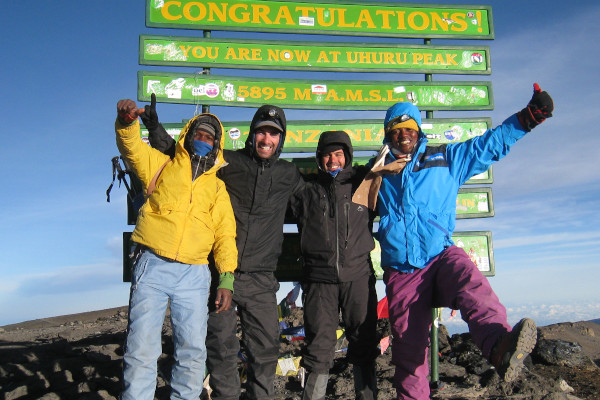
Plan your Kilimanjaro trek
Get a quote from my recommended local Kilimanjaro operator
Kilimanjaro Backpack FAQs
Can I take a backpack instead of a duffel bag?
Yes, you can take a camping backpack instead of a duffel bag.
But unless you're proficient at packing light, you will need to have a backpack with at least a 70 litre capacity. Here are some large capacity backpacks.
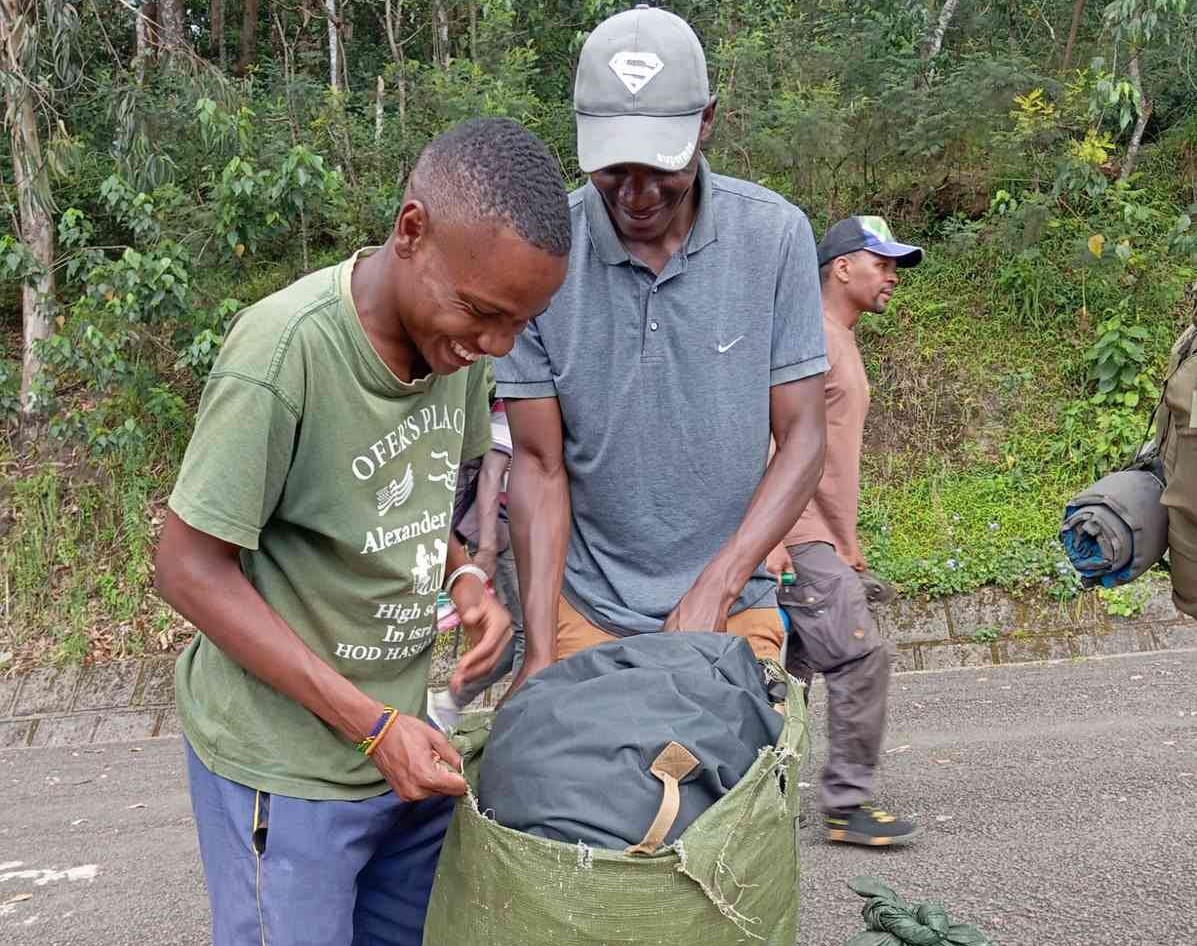
Porters packing a guest's duffel bag into a waterproof sack. A waterproof duffel bag is nice to have but not strictly necessary.
Do I need to carry my backpack or duffel?
Generally, no. Your main Kilimanjaro bag (whether a duffel bag or backpack) will be carried by a porter (read about Kilimanjaro porters) who will transport your gear from one camp to the next.
Porters carry bags on their head so it is important that your bag is soft and weighs no more than 20kg when fully loaded (some trek operators limit the weight to 15kg fully-loaded).
What characteristics should I look for in a bag?
- Ideally, greater than 80 litre capacity (hence why a duffel is the preferred choice)
- Constructed from waterproof laminate material to ensure your gear stays dry. We recommend packing your gear into separate plastic bags or packing units (see below) to provide extra waterproofing and easy access to sorted gear
- A strong zipper system that is not susceptible to breaking and can be easily locked. Take a small lock to secure your bag
- A hand and shoulder strapping system to provide extra versatility
What duffel bag do you recommend?
The market leader for large capacity duffel bags are The North Face and Helly Hansen. Both bags are great quality. I recommend you go for the 90L versions.
See more duffel bag options here.
What daypack should I take for Kilimanjaro?
In addition to your duffle bag (which is carried by your porter) you will be carrying your own daypack.
In your daypack you should keep all important gear (suncream, sunglasses, snacks, water), personal (money, passport etc.) or small breakable items (camera, phone etc.).
Your daypack should be small and lightweight. The lighter the better.
Key characteristics to look for in a good daypack:
- Compression straps to reduce weight stress on your back
- compartment for your water bladder and opening for the hose to thread through
- Side mesh pockets for easy access to your water bottle and other useful stuff
- Ensure your backpack has a rain cover
Best Daypack: Osprey Talon 22
The Osprey Talon 22 is a brilliant day pack that will easily fit all your essentials in a comfortable and well-supported bag.
The Talon is definitely a leader in the lightweight market, providing versatility, high performance and quality design in a neat multi-purpose pack. The daypack also features a special compartment to put your hydration bladder.
Two sizes are available: S/M (20L) and M/L (22L) and the bag retails for ~$100/£70. Both sizes are fine for Kilimanjaro.
Remember to grab an Osprey Hi-Visibility Raincover and Osprey Water Reservoir as well if you decide to get this day pack.
Best Value Daypack: The North Face Borealis
The North Face Borealis is a multi-purpose day pack. It includes all the key features that are required for climbing Kilimanjaro (including a hydration bladder compartment), as well as useful non-trekking features, such as a laptop compartment.
The Borealis has a 29L capacity and comes in at a cheaper price than the Osprey Talon.
Available in both men and women variants.
What other Kilimanjaro backpack accessories should I take?
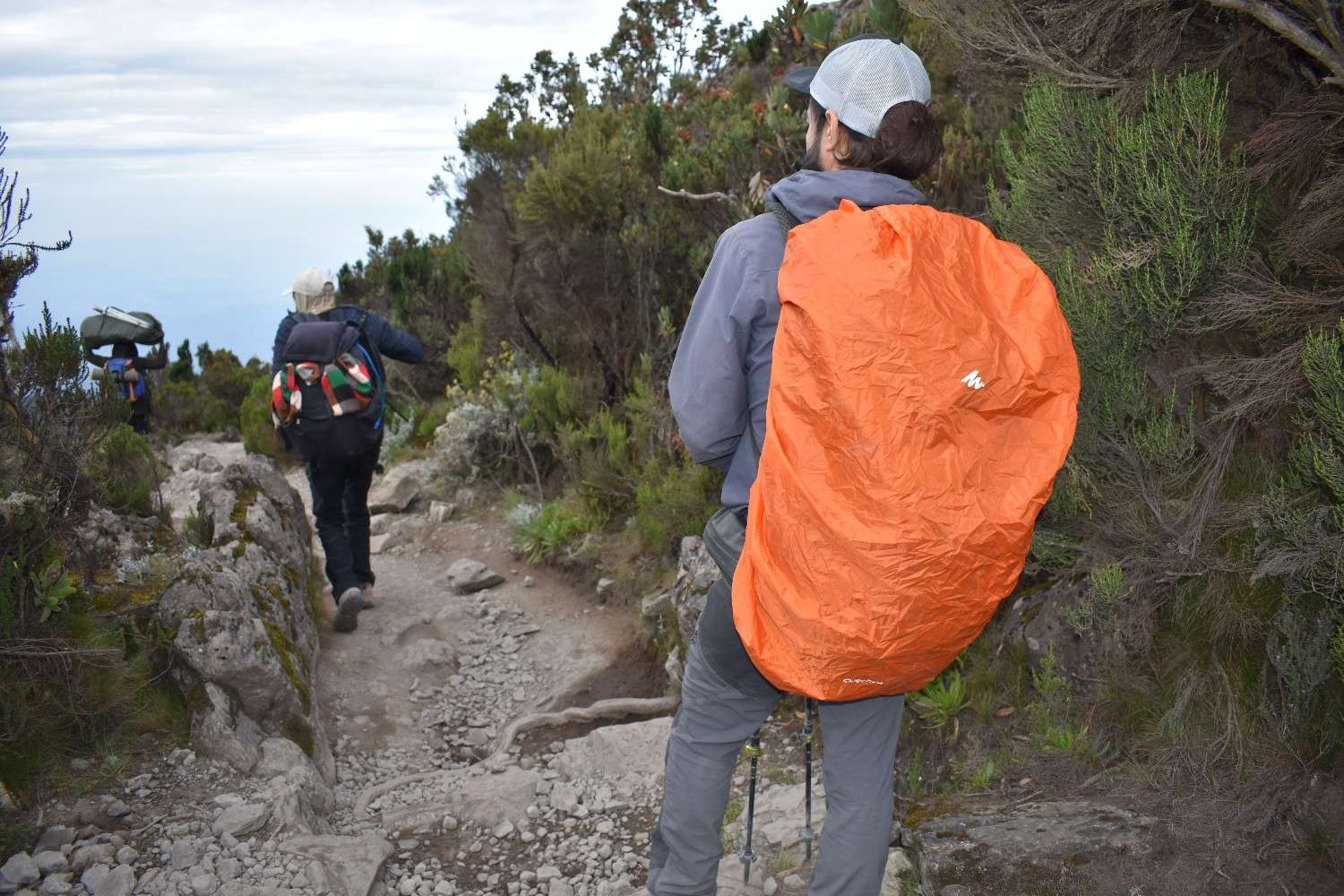
No matter what daypack you have it's important that it has a rain cover. These can also be purchased seperately.
Raincover
Depending on what time of the year you are hiking, there is a possibility that you will encounter rain on the mountain. You want to avoid getting your daypack wet. A good rain cover is a worthy piece of kit to have as a precaution.
If you are going with the Osprey Talon Backpack I would also get the Osprey Hi-Visibility Raincover, which retails for the standard backpack rain cover price and is super reliable. NB: select the right size cover (i.e. 19-30 litres).
Hydration Bladder
If you decide to go with a daypack which can hold a hydration bladder, then I suggest you purchase the best hydration bladder on the market. There is nothing worse than a leaky bladder!
The Platypus Big Zip Water Reservoir is undoubtedly the best product, hands down!. Where Osprey are strong in backpacks, Platypus rock the hydration bladder. The Platypus comes in a 2L and 3L version, the latter is ideal for Kilimanjaro.
Travel Bag Organisers
A pro tip that I have used to great effect on Kilimanjaro are travel bag organisers, which can be used to source separate your gear for better backing and access. They also provide a great way to separate wet or dirty gear.
Alternatively, if you want to go completely cheapo then use clear plastic bags to separate your gear.
Small TSA Lock
For obvious safety purposes you should be locking your Kilimanjaro bag. Here are some TSA locks.

Plan your Kilimanjaro trek
Get a quote from my recommended local Kilimanjaro operator
My Final Thoughts
And there you have it: Everything you need to know about picking and packing the perfect bag for Kilimanjaro. Looking for more in-depth gear guides? Check out these:
- Clothing for Kilimanjaro
- Hiking boots for Kilimanjaro
- Sleeping bags for Kilimanjaro
- Hiking poles for Kilimanjaro
- Water on Kilimanjaro
- Headlamps for Kilimanjaro
Still have questions about Kilimanjaro bags? Leave a comment below and I'll respond within 24hours.

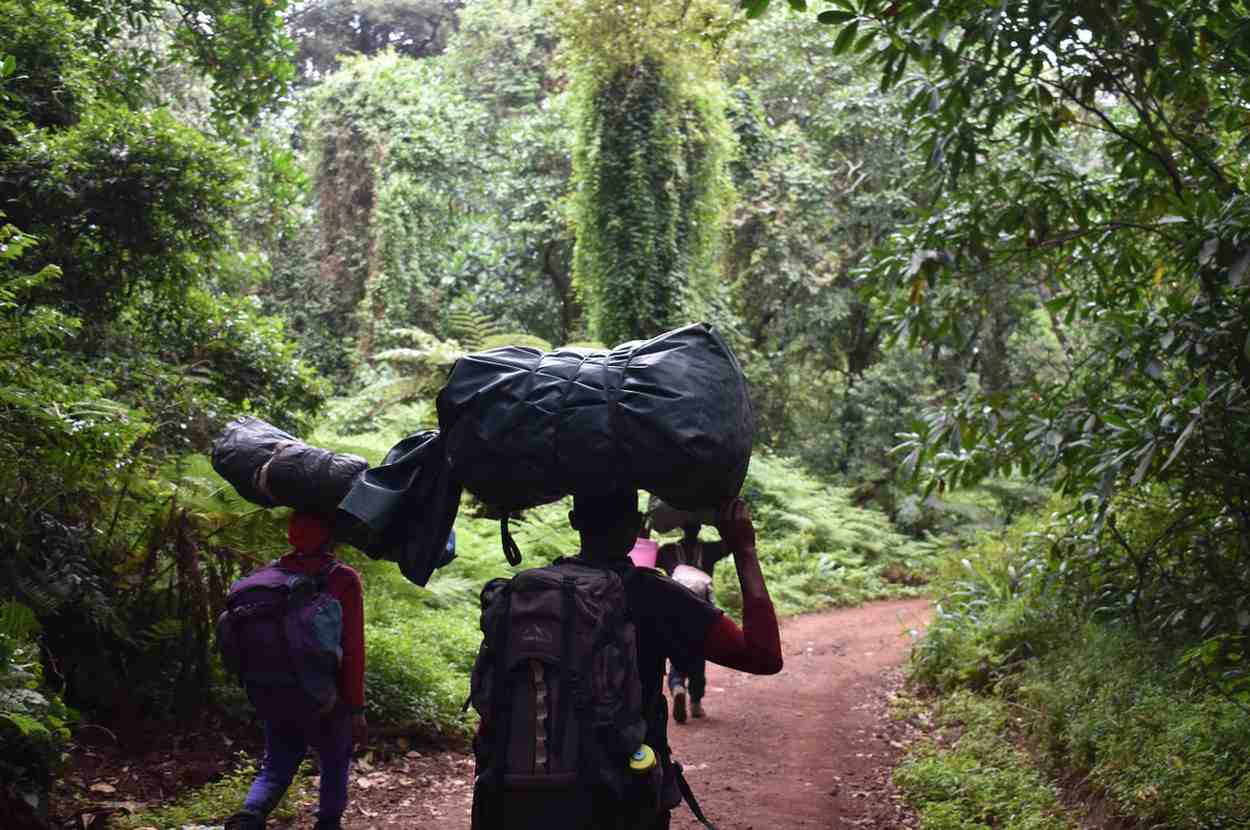
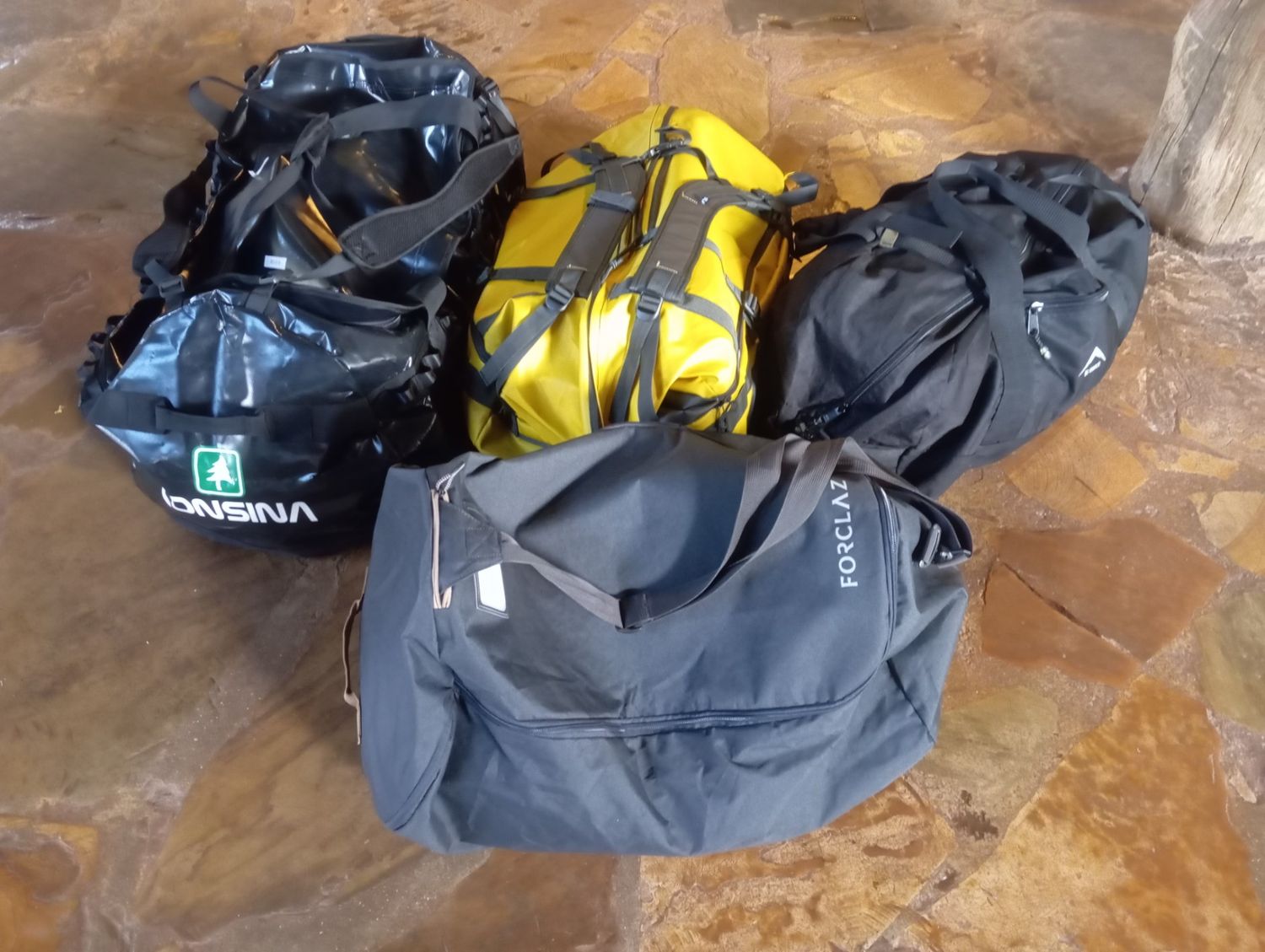






Hi,
Regarding duffel bags for Kilimanjaro, I read that you recommend 90 liters.
I hike in New Zealand and I find that I have more than enough space in my 65 litre pack for multi day hikes including my sleeping & cooking system.
If I'm going to hike Mt Kilimanjaro with a personal day pack of around 25 liters, I'm confused what I'm going to need such a big duffel for.
What am I missing?
Regards,
Lane
Hi Lane, it’s possible to pack much lighter than 90L, but as the trek is 7-8 days long and requires multiple layers of clothing for the change in weather conditions, it can mean you need a bigger bag. Once you factor in your sleeping bag (needs to be a 4-season bag), it’s quite easy to fill 70-80L.
I have 20ltr daypack which I would like to use for kili. Will this be okay and not too small? I'm trying to avoid additional costs where possible
Hey Dee, yes, if you can pack light then a 20L will suffice.
I saw you recommend plastic bags to separate items in portage. This is not possible. Plastic bags are banned in Tanzania. OK the ban came in after the recommendations where written.
Thanks for the heads up Steve, I didn’t know Tanzania had changed it’s regulations on plastic bags.
I hike Kilimanjaro and then have a three day safari afterwards. I purchased the Patagonia Black Hole 120L. My concern is hauling the duffle when there’s no Sherpa (e.g. airport, to hotel,etc). There’s a huge price difference for the one with wheels $200. I notice no one mentions duffles with wheels. Is it worthwhile to have? Or a waste.
Hi Sheri, a duffle with wheels is not required for Kilimanjaro and just adds extra weight. The Black Hole is sufficient for the trip but will mean a little carrying at airports ect.
Regarding the North Face Duffel – I have one that’s been with me on dozens of trips and I love it but it is NOT totally waterproof.
I’ve had it strapped to the back of my motorbike in heavy rain and during times like this water gets in through the bottom of the bag (which isn’t the same material as the rest) and through the zipper (the flap doesn’t cover it perfectly).
Hi Stef, the more recent North Face Duffels should be fully waterproof, but the bottom and zip areas are admittedly weak spots.
Hey there,
I am climbing Kili in September and have a question regarding the summit night.
Would you recommend an insulated tube for my 3L Platypus? The friendly people working in my frequent outdoor shops recommend using wide mouths Nalgene bottles (which will be stored in my 36L Osprey Sirrus to prevent from freezing), however I am worried about stressing to stay hydrated while focusing on trying to summit. Also, have tested and cannot seem to get my tube under my clothing.
What would you advice and do you have any tips on preventing the tube from freezing?
Hi Candice, I generally don’t use insulated tubes as I find them cumbersome. If you can find a way to insulate the tube in your jacket hoodie or underneath a neck gaiter then you should be fine. The key is to protect the mouth piece from freezing, make sure to always blow back residual water after each drink. It might also be worthwhile taking a spare water bottle in your daypack on summit night. You can insulate this with a warm sock and keep it buried in your pack, not on the outside. Hope this helps.
Hi! I have read that the Talon 22 doesn’t have much air flow and that it gets uncomfortable while hiking- have you found this to be the case? I was looking at the Osprey Manta 36 instead. Please advise 🙂
Hi Kate, yes, the Talon 22 doesn’t have great air flow at the back because it is such a small / lightweight daypack. The Manta would provide much better air flow but is obviously bigger in size. Personally I would go for the larger daypack as it provides more versatility in the long-run. Cheers!
Hi there. I have a Futura Pro 38 bag by Deuter, would that be too big for the day pack? I also have a sleeping bag that’s good up to -19 for a feb climb, is that be warm enough?
Hi Jess, both your daypack and your sleeping bag sounds great and up for the challenge. All the best!
Hi Sam, I like your blog. Please keep it up. Actually, I like travelling but I don’t like heavy backpacking. So the Osprey Talon 22 will be the best for me. But I have a question. Does the Osprey 22 is hydration reservoir system? I think it will be very comfortable. Thanks!
Sincerely,
Adalina
Hi,
Im booked in to hike Kilimanjaro in August and wondering if the bag for the porter has to be a duffel or is my 70L Katmandu Backpack with harness going to be sufficient for them? The Backpack is soft and harness folds away if wanted…
Regards
Hi Reilly, Your 70L Kathmandu Backpack will work fine! All the best for your trek!
Hey guys,
I have an Osprey Talon 18 and Kestrel 48. I feel like the talon is too small for the daypack and the kestrel is too big. Should I buy a 20-30L daypack or will I be able to get by with the 18L?
Thanks,
Also, I am also bringing a 90L duffel for my things so I don’t mind keeping a little extra in my duffel. I’m mostly worried about the temperature changes and having enough layers in my daypack.
Hi Sam, an 18L is a little bit on the small side, and I would say the 48L is too big. You can get away with the 18L if you are like me and stay super light, i.e. just a hard shell jacket, snacks and water in the daypack, but if you want to carry anything more than you’ll find 18L will be too small. Ideal size is 25-35L.
Thanks! I just took this bag to Iceland for some mountain and glacier hiking to test it out for Kili. My biggest issue was not being able to fit both my packable down and mid weight soft shell jacket (500g) comfortably along with my gloves and gaiters. Also, the 3L platypus bladder was hard to push into the back of the talon 18. I will probably go with a talon 33 and meet in the middle.
Hi. I have the duffel bag in M (72L). I purchased it a while ago, do you think it would be sufficient?
You should be fine with a 72L duffel. You might need to carry more in your daypack though! All the best!
Hi. I know this thread is a bit older, so hopefully I’ll get a response. I’m only 5’3″ and am worried that a 90L duffle bag would be too large for me. However, I’m not sure if a 60L will fit my sleeping bag along with other gear. Specs are: 3lbs, 10 oz; stuff sack size 9.5″ x 19″, stuff sack volume is 22.1 L. On the topic of sleeping bag, it’s rated 0 degrees F (EN for women 3.2F). Do you think that’s warm enough? BTW…I’m a tropical wimp from South Florida. Thanks
Hi Tadji, your duffle back will be carried by a porter so size shouldn’t be a problem. I recommend bags over 80L, a 60L or below tends to be too small to fit all of one’s gear and sleeping bag. That being said, if your pack really light you could probably fit everything into a 60L. In terms of your sleeping bag, 0 degrees F should be more than warm enough. Cheers!
I’m a bit worried about the size of the daypack because I’m only 5′ 3″. Some people have recommended a carrying size of 30L but would a smaller sized bag still suffice? If so, how small of a bag could I realistically get away with? Thanks!
Hi Courtney, you can really get away with a very small bag if you only want to carry the essentials. You need to be able to carry water (approx. 2L), snacks, your camera, suncream, hat, spare fleece and some personal items. So a small daypack can work. Obviously if you want to carry more things, like additional layered clothing then your bag needs to be a little bigger. Generally I travel light, with a small daypack.
Does the bag need to be a duffel bag or can I use my 70l backpack?
Hi Michael, a 70l rucksack would work fine. Your porter carries your bag so as long as it can carry your sleeping bag and gear and not weigh more than 20kg you will be all set.
I am planning a climb in July, since its very cold I opted for the North face Dark star (-29C). However its a big sleeping bag that doesn’t compress well. I didn’t care much until I read your comment that it should be inserted in the Duffle bag. I was planning to buy the 90L North face base camp you recommended, But now I am thing the XL would be needed, is that a problem with the porters? Or is the weight the only issue (15kg) and size is irrelevant.
Appreciate your input on this
Hi Karim, The size of the bag is not too much of an issue, as long as you can keep the weight down. I suspect a 90L North Face should be able to accommodate your Dark Star sleeping bag as well as all your other gear, but if you think the XL option is necessary I don’t see that as a major issue for your support crew. As a rule of thumb though the lighter the better. All the best for your climb!
Same issue here, just realised the same with the Dark Star /North Face L and am thinking about going for the XL too. How did it go for you? Did you make the change or sticked to the L?
Thank you
Hi Edgar, It’s unlikely Karim will answer back but as I said above a 90L duffle should be large enough to accommodate all your gear and sleeping bag. If not than an XL will be fine as long as you keep the total weight of the bag to less than 20kg (ideally 15kg). Check weight restrictions with your tour operator. Cheers!